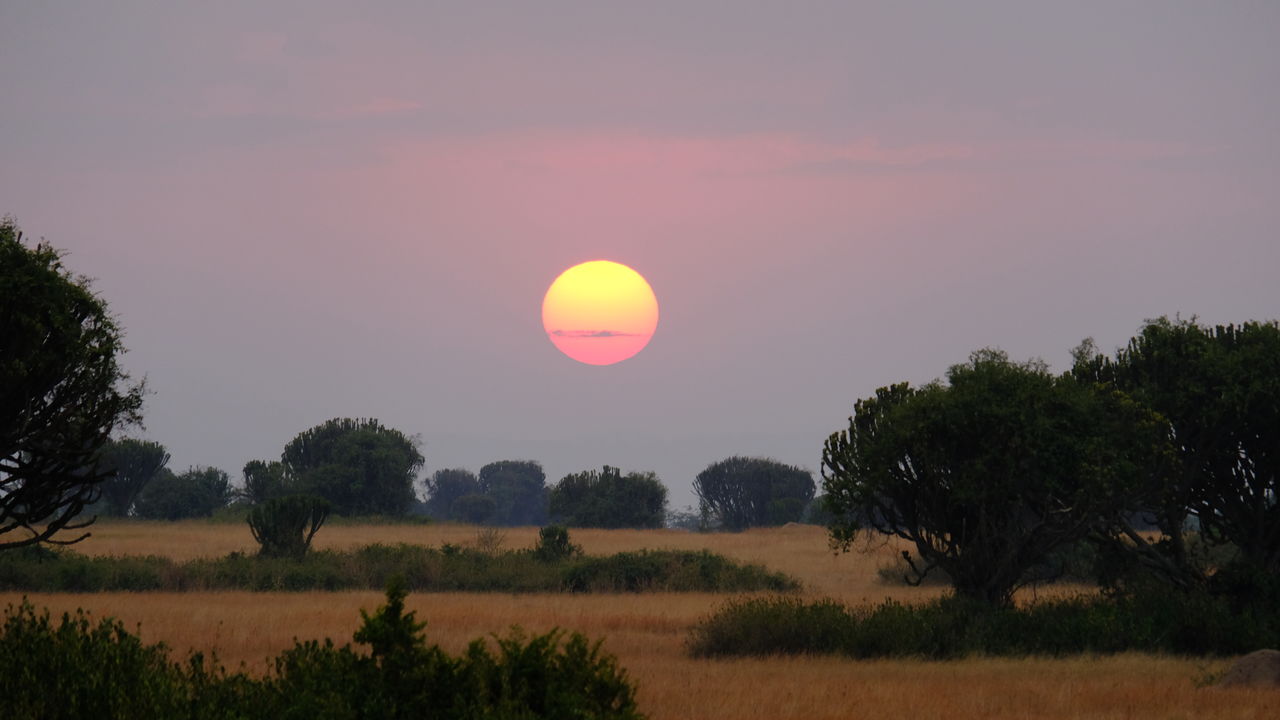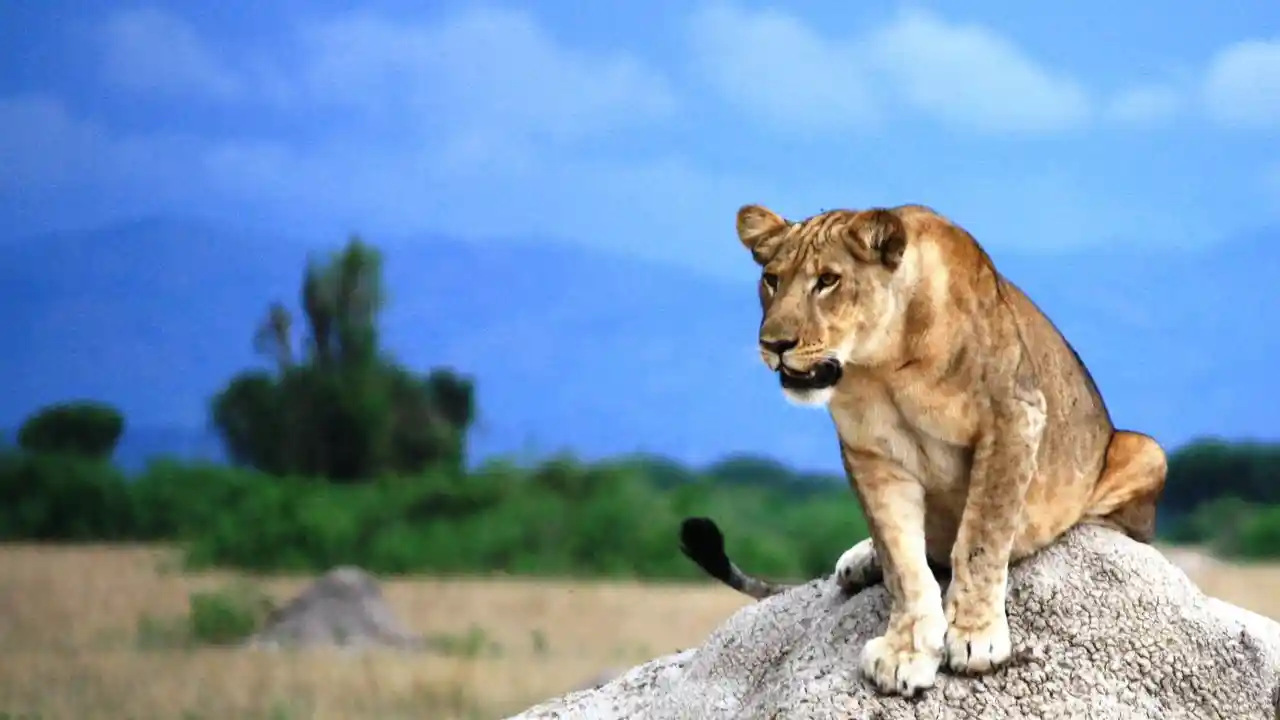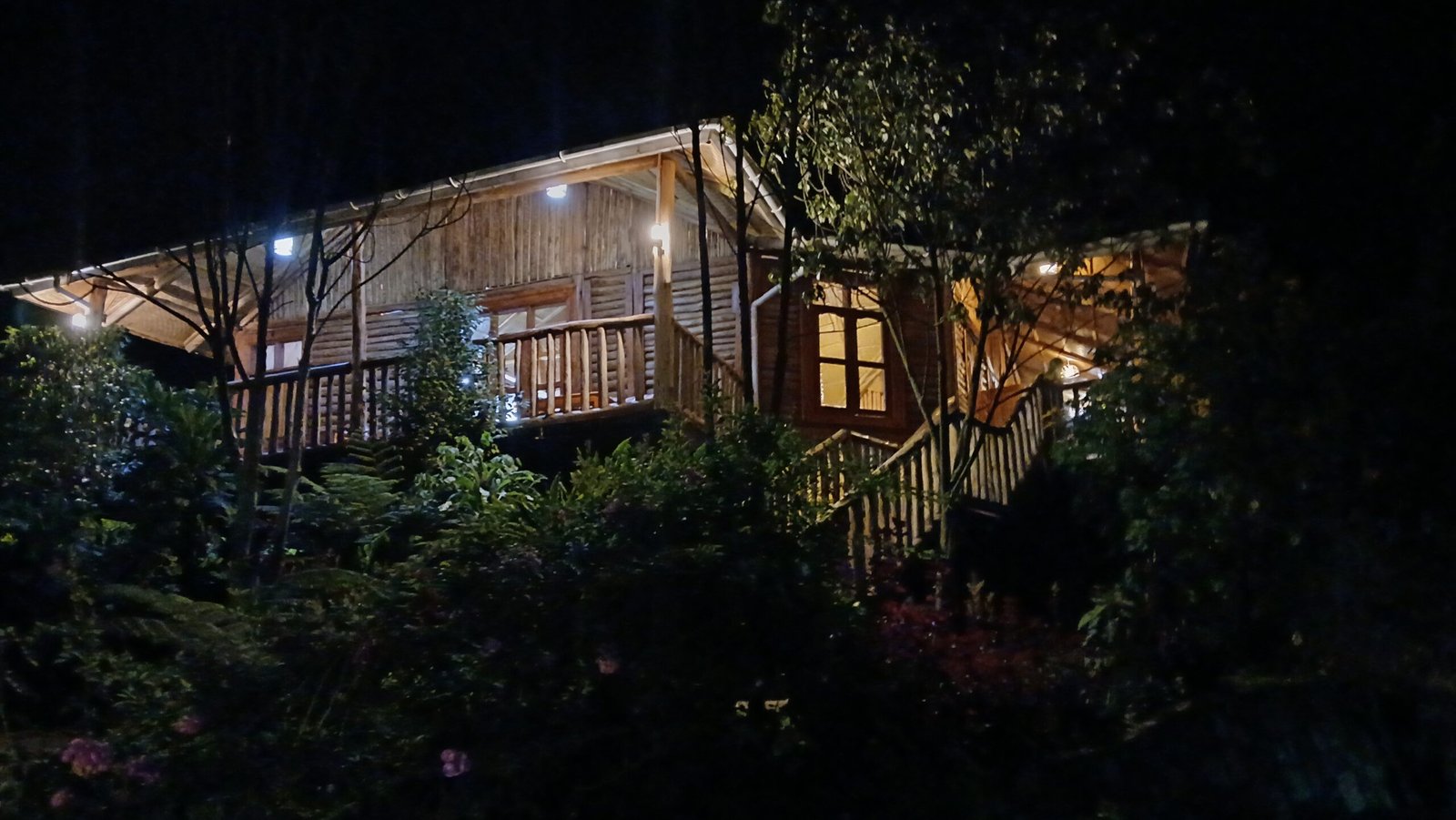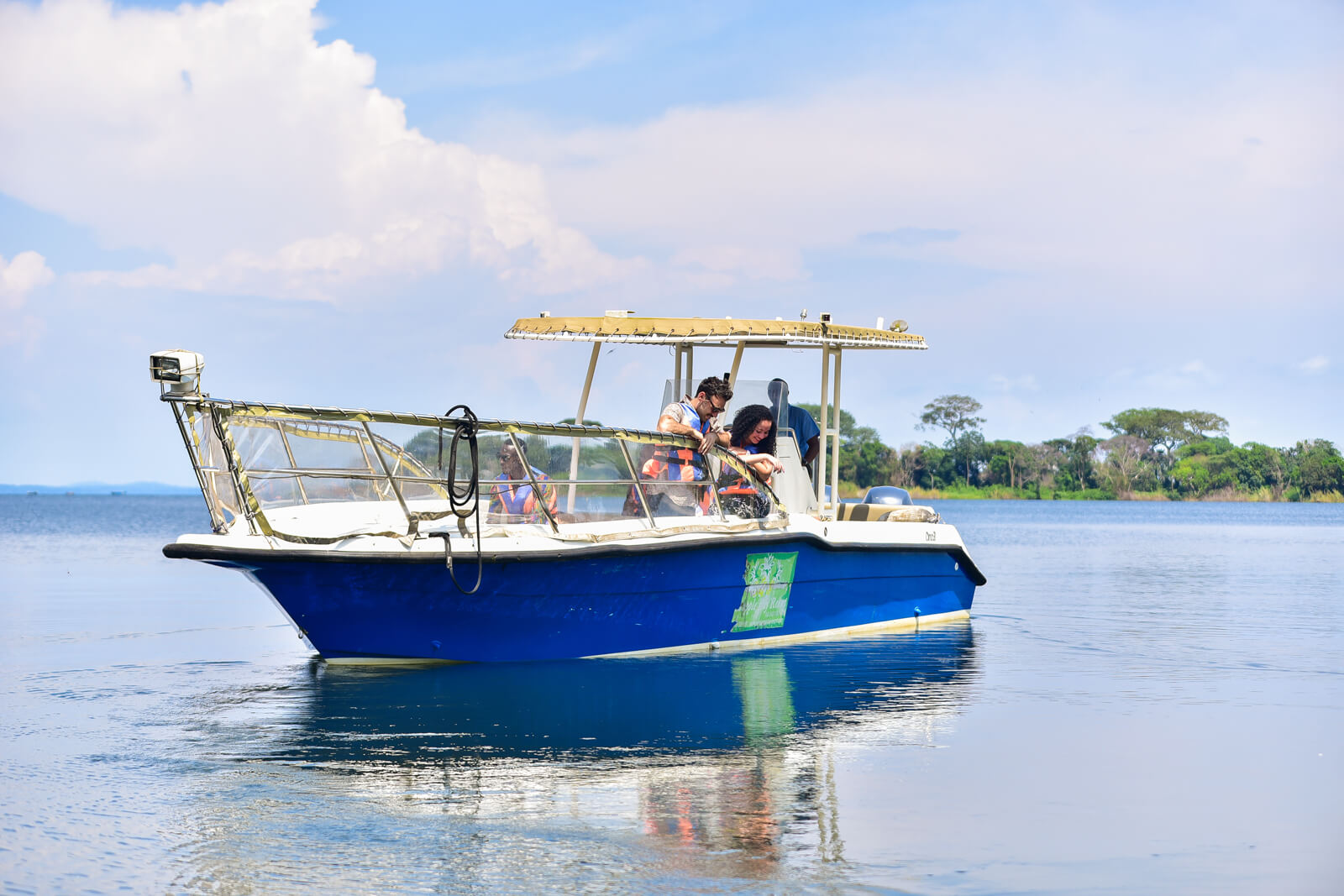Queen Elizabeth National Park
Queen Elizabeth National Park
The Queen Elizabeth National Park of almost 2000 square kilometers is located in southwestern Uganda. It’s about a 7-hour drive from Kampala and sits right on the Equator, close to Uganda’s famous gorilla trekking spots. On the journey here, you can pass from one hemisphere to the other, pausing at zero degrees to take photos. This park sits on the floor of the Great Rift Valley, where lakes, rivers, wetlands, forests and grasslands create one of Africa’s most diverse ecosystems. It is nestled between Lake Edward and Rwenzori Mountains— a range of snow-capped peaks suitably described by ancient geographer Ptolemy as ‘mountains of the moon’.
Queen Elizabeth National Park is Uganda’s most visited destination for those seeking a traditional savannah safari experience. The national park supports an extraordinary variety of animal, including nearly 100 mammal species and 600 types of birds. Elephants roam the savannah, lions climb trees, and hippos crowd the waterways. You can also spot chimpanzees and monkeys, along with leopards, hyenas, warthogs and giant forest hogs.



Why go on safari in Queen Elizabeth National Park?
1. A UNESCO Man and Biosphere Reserve
In the many African national parks and reserves settlements are banned, but Queen Elizabeth National Park is different. The park is part of a UNESCO Man and Biosphere Reserve where rural communities, visitors and wildlife coexist. When the national park was created in 1952, its dozen or so villages remained, their residents scratching a living by growing bananas, tending smallholdings, mining salt, and fishing for ngege (Nile tilapia, delicious grilled) or emamba, emale and semutundu (lungfish, mudfish and catfish). This unique balance of nature, local life, and wildlife makes Queen Elizabeth National Park a fascinating place to visit.
2. The Tree Climbing Lions in the Ishasha Sector
Unlike their leopard cousins, African lions are not naturally skillful tree climbers. Their impressive bulk makes them the top predators, giving them strength pull down powerful prey, but they are not well designed for nimble balance or agile leaps. While all lions can climb trees occasionally, it is very rare that they make a habit of it.
However, in the remote Ishasha area of Queen Elizabeth National Park, the lions are known for their arboreal tendencies. As you drive through, you might spot their tawny forms draped across thick branches, with their tails swaying gently in the breeze. The best time to see them is during the hot midday hours when they rest up high to stay cool away from the warm ground.
3. Kazinga Channel Boat Cruise
The Kazinga Channel is a squiggle of fresh water, roughly 35 km long and 2,500 ft wide. Although it is officially a river, its flow is so slow that it is hardly noticeable. This channel connects two freshwater lakes — Lake Rutanzige (also known by its colonial name, Lake Edward) and Lake Katunguru (also called Lake George).
The Kazinga Channel is the lifeblood of Queen Elizabeth National Park and attracts a varied range of birds and animals to its water, including one of the world’s largest concentrations of hippos year-round. Taking a boat ride on the channel is one of the best experiences during a visit to the park.
4. Nature Walk in Maramagambo Forest
This ancient forest is full of mystery and hidden secrets. Its name comes from a local phrase meaning “the end of words,” which refers to a legend about a group of young people who got lost in the forest many years ago. It took them several days to find their way back to their village, and when they finally returned, they were so exhausted they couldn’t speak for a long time. That’s why the forest is called “Maramagambo,” meaning “the end of words.” On a nature walk here, you’ll follow trails under huge trees, where black-and-white colobus monkeys leap through the treetops. The forest floor is full of life, from colorful butterflies to the small forest duiker, giving you a close-up look at this lively and vibrant ecosystem.
5. Chimpanzee Trekking in Kyambura Gorge
Kyambura Gorge is an 11 km long crack in the Earth’s crust inside Queen Elizabeth National Park. Located south of the Kazinga Channel, this stunning gorge was named after Kyambura River that flows through its dense “underground rainforest”, 100 meters below the Kichwamba Escarpment of the Rift Valley.
Living within this underground forest are many monkeys, birds and butterflies. But, Kyambura is best known for a small, isolated community of 30 chimpanzees that have become known as the “Lost Chimpanzees”. Most visitors to Queen Elizabeth National Park skip the Gorge, and only the adventurous hike 100 meters down into this mysterious rainforest called “the Valley of the Apes” by BBC. Discover it and you may glimpse chimpanzees’ knuckle prints, or hear their screeches reverberating through the trees.
6. Explosion Craters
Queen Elizabeth NP sits in Africa’s Great Rift Valley, which was formed millions of years ago by volcanic and tectonic activity. This upheaval has left behind an eye-bending array of rugged peaks, ancient craters, and lush green hills that are a delight to explore. The park is home to 41 volcanic craters, with 28 of them hold sparkling crater lakes. The largest crater area is called Katwe. It is a volcanic field of around 200km2, pocked with ancient craters like the surface of the moon, but with more greenery.
Unlike other volcanic areas, there are no lava flows here. Instead, these craters were created by violent explosions of hot gas and steam, leaving behind a rugged landscape. A game drive through this area or a walk along the crater rims offers amazing views of the park and the distant Mountains of the Moon. The craters are a fascinating part of the park’s landscape, offering a chance to explore both wildlife and geology in one incredible experience.
7. Game Drives
In Queen Elizabeth National Park, you can spot four of Africa’s “Big Five” animals (except rhinos). Early morning drives across the plains show lions beginning their day, herds of Uganda kob standing watch, and elephants roaming between acacia trees. The Kasenyi plains are full of wildlife, with leopards occasionally appearing from the grass and hyenas lazily heading back to their dens.
8. Predator Tracking
On this safari, you’ll go with a biologist from the park who will study the behavior and movements of different lion prides and individual leopards. This gives you a chance to see the savannah through the eyes of a scientist and learn about the “king of the jungle” in a special way! The lions are tracked by radio collars, so you’ll always be able to find them, though leopards aren’t guaranteed. Since you’re with the biologist, you’ll also be able to go off the usual paths. The money from this experience helps fund the research.
9. Bird Watching
While smaller than famous safari spots like the Maasai Mara in Kenya or the Serengeti in Tanzania, Queen Elizabeth National Park harbours considerably more avian species: over 600, in fact, a number that, according to BirdLife International, no protected area in Africa can beat. On a bird-watching safari, you might see martial eagles soaring in the sky, and the ancient-looking shoebill hiding in the papyrus swamps. In the morning, the park comes alive with a symphony of bird songs, from the unique calls of grey-crowned cranes to the metallic sound of black-headed gonoleks.
10. Cross the Equator
A popular photo stop on a safari in Queen Elizabeth National Park is the Equator. This imaginary line that divides the Earth is marked by a large circle. Nearby is the Queen’s Pavilion, which was originally a temporary shelter for Queen Elizabeth II and the Duke of Edinburgh during their visit in 1954. Five years later, a permanent pavilion was built for a visit by Queen Elizabeth, the Queen Mother. Today, there’s also a new information center with internet access and a coffee shop.

Queen Elizabeth National Park Accommodation
Queen Elizabeth National Park has a range of places to stay, from luxury lodges to cozy tented camps. Bush lodges, built on raised platforms, give you amazing views of the savannah, while smaller tented camps let you experience nature up close, with plenty of comfort. Some accommodations are near the Kazinga Channel, so you can watch wildlife from your own private veranda. Others are located on the edge of extinct volcanoes, offering stunning views of the surrounding area. Orugano Safaris travel consultants can help you include a stay at one of our recommended properties in your trip.
Orugano Bwindi Lodge
Our lodge, Orugano Bwindi Lodge, is the perfect place to stay if you’re planning to go gorilla trekking in the Nkuringo Sector of Bwindi. It’s close to both the Virunga Volcanoes in Mgahinga Gorilla National Park and the beautiful Lake Mutanda. The Nkuringo area is home to several gorilla families, including Nkuringo, Bushaho, Christmas, Nkuringo, and Posho. This part of Bwindi is known for being the most scenic, with stunning views of the Virunga volcanoes.
How much is it to visit Queen Elizabeth?
Uganda Safari packages focused only on Queen Elizabeth National Park usually cost between US$200 and US$500 per person per day. Tour packages that include chimpanzee trekking will cost a bit more, and those with a gorilla trekking permit will be much higher. The price typically covers accommodation, meals, transport, park fees, and activity costs, but doesn’t include tips, extra activities, drinks, or personal expenses.
How to Get to Queen Elizabeth National Park?
Queen Elizabeth National Park is about 400km from Kampala, which is a 7-hour drive through beautiful countryside on well-maintained roads. Alternatively, you can take a domestic flight from Entebbe to Kasese or Mweya airstrips to shorten the trip. Many safaris in the park are combined with gorilla tour in Bwindi and/or chimp trekking in Kibale Forest. Depending on where you stay in Queen it’s only a 2- to 6-hour drive to Bwindi Impenetrable Forest. You can also drive between Queen Elizabeth NP and Mgahinga Gorilla National Park.







